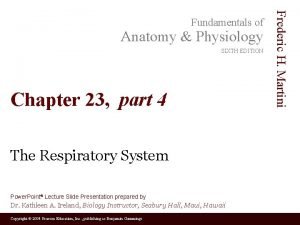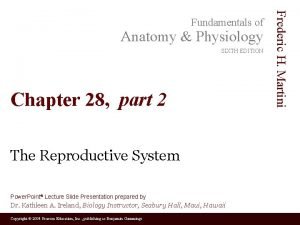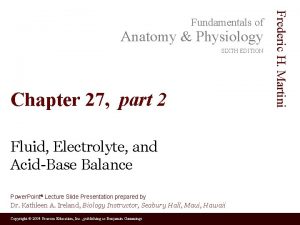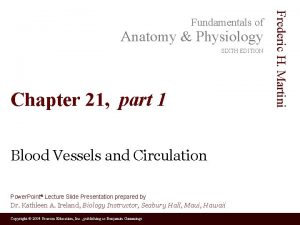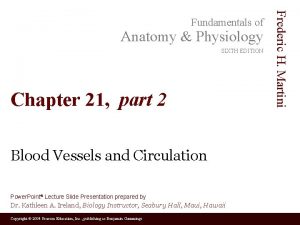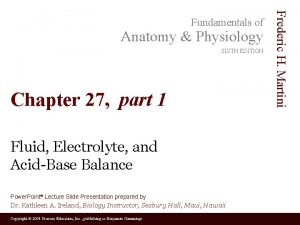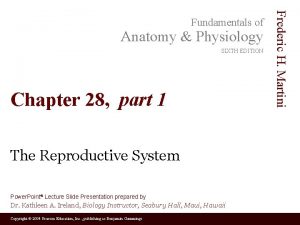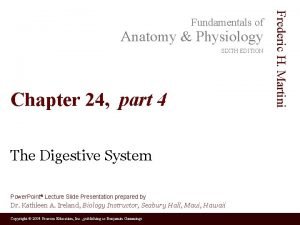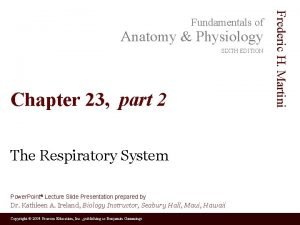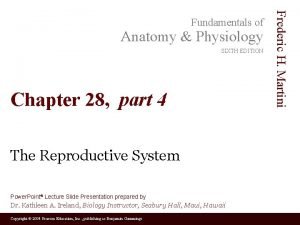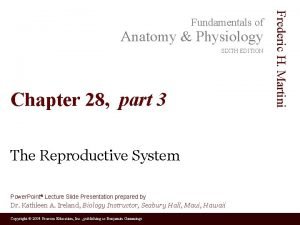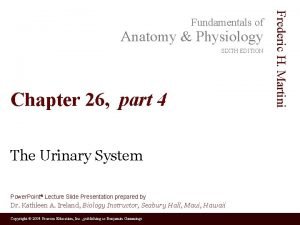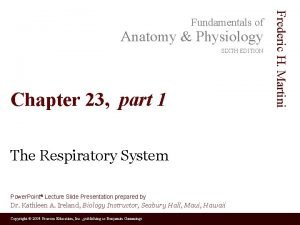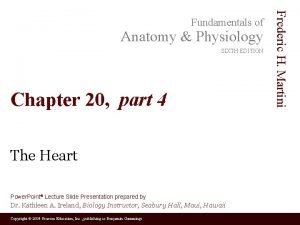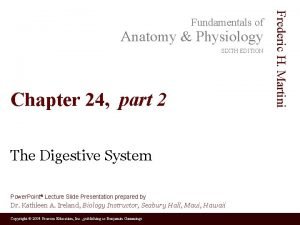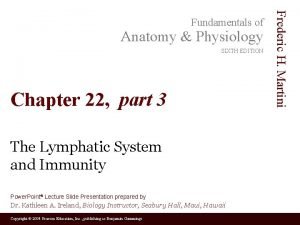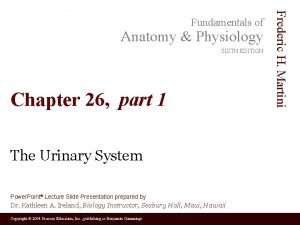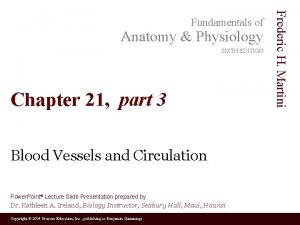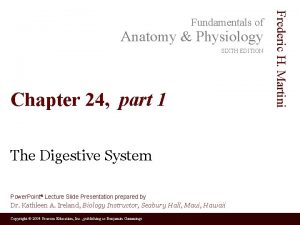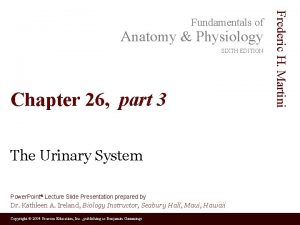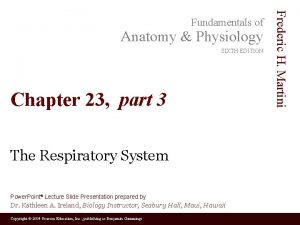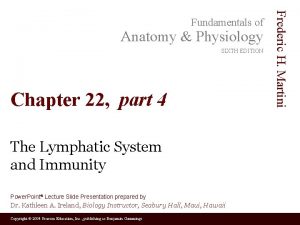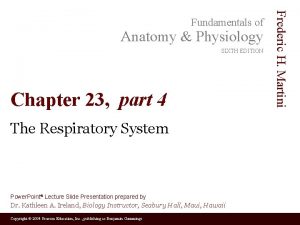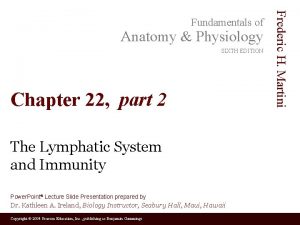Anatomy Physiology SIXTH EDITION Chapter 29 part 1






























- Slides: 30

Anatomy & Physiology SIXTH EDITION Chapter 29, part 1 Development and Inheritance Power. Point® Lecture Slide Presentation prepared by Dr. Kathleen A. Ireland, Biology Instructor, Seabury Hall, Maui, Hawaii Copyright © 2004 Pearson Education, Inc. , publishing as Benjamin Cummings Frederic H. Martini Fundamentals of

Learning Objectives • Explain the relationship between differentiation and development and specify the various stages of development • Describe the process of fertilization • List the three prenatal periods and describe the major events associated with each • Discuss the importance of the placenta as an endocrine organ Copyright © 2004 Pearson Education, Inc. , publishing as Benjamin Cummings

Learning Objectives • Discuss the structural and functional changes in the uterus during gestation • List and discuss the events that occur during labor and delivery • Relate basic principles of genetics to the inheritance of human traits Copyright © 2004 Pearson Education, Inc. , publishing as Benjamin Cummings

SECTION 29 -1 An Overview of Topics in Development Copyright © 2004 Pearson Education, Inc. , publishing as Benjamin Cummings

Differentiation and development • Development • Gradual modification of physical and physiological characteristics • Differentiation • The creation of different types of cells Copyright © 2004 Pearson Education, Inc. , publishing as Benjamin Cummings

Stages of development • Prenatal development • Embryological • Changes occurring the first two months after fertilization • Fetal • Begins at the start of the ninth week and continues until birth • Postnatal development • Commences at birth and continues to maturity Copyright © 2004 Pearson Education, Inc. , publishing as Benjamin Cummings

SECTION 29 -2 Fertilization Copyright © 2004 Pearson Education, Inc. , publishing as Benjamin Cummings

Fertilization (conception) • Occurs in the uterine tubes • Within a day of ovulation • Spermatozoa cannot fertilize an ovum until after capacitation Copyright © 2004 Pearson Education, Inc. , publishing as Benjamin Cummings

Figure 29. 1 Fertilization Copyright © 2004 Pearson Education, Inc. , publishing as Benjamin Cummings Figure 29. 1 a

Figure 29. 1 Fertilization Copyright © 2004 Pearson Education, Inc. , publishing as Benjamin Cummings Figure 29. 1 b

The Oocyte at Ovulation • Oocyte is in meiosis II • Surrounded by the corona radiate • Spermatozoa release hyaluronidase and acrosin • Enzymes required to penetrate corona radiate • Single spermatozoan contacts oocyte, fertilization begins • Oocyte activation PLAY Animation: Fertilization and Oocyte Activation Copyright © 2004 Pearson Education, Inc. , publishing as Benjamin Cummings

Oocyte activation • Oocyte completes meiosis II • Functionally mature ovum • Female pronucleus and male pronucleus fuse (amphimixis) • Polyspermy prevented by membrane depolarization and cortical reaction Copyright © 2004 Pearson Education, Inc. , publishing as Benjamin Cummings

SECTION 29 -3 The Stages of Prenatal Development Copyright © 2004 Pearson Education, Inc. , publishing as Benjamin Cummings

Embryonic and Fetal Periods • Induction • During prenatal development differences in cytoplasmic composition trigger changes in genetic activity • Gestation periods • Three trimesters Copyright © 2004 Pearson Education, Inc. , publishing as Benjamin Cummings

SECTION 29 -4 The First Trimester Copyright © 2004 Pearson Education, Inc. , publishing as Benjamin Cummings

The First Trimester • Cleavage • Zygote becomes a preembryo then a blastocyst • Implantation • Blastocyst burrows into uterine endometrium • Placentation • Blood vessels form around blastocyst and placenta develops • Embryogenesis • Formation of a viable embryo Copyright © 2004 Pearson Education, Inc. , publishing as Benjamin Cummings

Cleavage and blastocyst formation • A series of cell divisions that subdivides the cytoplasm of the zygote • Trophoblast – outer layer of cells • Inner cell mass – cluster of cells at one end of blastocyst Copyright © 2004 Pearson Education, Inc. , publishing as Benjamin Cummings

Figure 29. 2 Cleavage and Blastocyst Formation Copyright © 2004 Pearson Education, Inc. , publishing as Benjamin Cummings Figure 29. 2

Implantation • Occurs about 7 days after fertilization • Trophoblast enlarges and spreads • Maternal blood flows through open lacunae • Gastrulation • Embryonic disc composed of germ layers • Endoderm • Mesoderm • Ectoderm Copyright © 2004 Pearson Education, Inc. , publishing as Benjamin Cummings

Figure 29. 3 Stages in Implantation PLAY Animation: Location of the Endometrium Copyright © 2004 Pearson Education, Inc. , publishing as Benjamin Cummings Figure 29. 3

Figure 29. 4 The Inner Cell Mass and Gastrulation Copyright © 2004 Pearson Education, Inc. , publishing as Benjamin Cummings Figure 29. 4

Germ layers • Gastrulation • By day 12 surface cells move toward the primitive streak • A third germ layer forms • The three germ layers are: • Ectoderm – superficial cells that did not migrate • Endoderm – cells facing the blastocoele • Mesoderm – migrating cells between ectoderm and endoderm Copyright © 2004 Pearson Education, Inc. , publishing as Benjamin Cummings

Extraembryonic Membranes • Four extraembryonic membranes: • Yolk sac • Amnion • Allantois • Chorion Copyright © 2004 Pearson Education, Inc. , publishing as Benjamin Cummings

Figure 29. 5 Extraembryonic Membranes and Placenta Formation Copyright © 2004 Pearson Education, Inc. , publishing as Benjamin Cummings Figure 29. 5 a, b

Figure 29. 5 Extraembryonic Membranes and Placenta Formation Copyright © 2004 Pearson Education, Inc. , publishing as Benjamin Cummings Figure 29. 5 c, d

Figure 29. 5 Extraembryonic Membranes and Placenta Formation Copyright © 2004 Pearson Education, Inc. , publishing as Benjamin Cummings Figure 29. 5 e

Embryo Anatomy • Yolk sac • Important site of blood cell formation • Amnion • Encloses fluid that surrounds and cushions developing embryo • Allantois • Eventually becomes bladder • Chorion Copyright © 2004 Pearson Education, Inc. , publishing as Benjamin Cummings

Figure 29. 6 A Three-Dimensional View of Placental Structure Copyright © 2004 Pearson Education, Inc. , publishing as Benjamin Cummings Figure 29. 6 a

Placentation • Chorionic villi extend into maternal tissue • Forms intricate branching network for maternal blood • Umbilical cord connects fetus to placenta Copyright © 2004 Pearson Education, Inc. , publishing as Benjamin Cummings

Hormones of the placenta • Trophoblast secretes hormones to maintain pregnancy • HCG • Estrogens • Progesterone • h. PL • Placental prolactin • relaxin Copyright © 2004 Pearson Education, Inc. , publishing as Benjamin Cummings
 3 layers of muscle
3 layers of muscle Anatomy and physiology edition 9
Anatomy and physiology edition 9 Human anatomy and physiology 10th edition
Human anatomy and physiology 10th edition Peter pickle tongue twister
Peter pickle tongue twister The sixth sick sheik's sixth sheep's sick lyrics
The sixth sick sheik's sixth sheep's sick lyrics The central sulcus divides which two lobes? (figure 14-13)
The central sulcus divides which two lobes? (figure 14-13) Waistline
Waistline Anatomy and physiology chapter 8 special senses
Anatomy and physiology chapter 8 special senses Chapter 13 anatomy and physiology of pregnancy
Chapter 13 anatomy and physiology of pregnancy Chapter 2 basic chemistry anatomy and physiology
Chapter 2 basic chemistry anatomy and physiology Anatomy and physiology chapter 7
Anatomy and physiology chapter 7 Anatomy and physiology coloring workbook figure 14-1
Anatomy and physiology coloring workbook figure 14-1 Chapter 10 blood anatomy and physiology
Chapter 10 blood anatomy and physiology Anatomy and physiology chapter 15
Anatomy and physiology chapter 15 Anatomy and physiology chapter 1
Anatomy and physiology chapter 1 Holes anatomy and physiology chapter 1
Holes anatomy and physiology chapter 1 Anatomy and physiology chapter 15
Anatomy and physiology chapter 15 Medial lateral distal proximal
Medial lateral distal proximal Chapter 2 human reproductive anatomy and physiology
Chapter 2 human reproductive anatomy and physiology Anterior surface of scapula
Anterior surface of scapula Chapter 6 general anatomy and physiology
Chapter 6 general anatomy and physiology Olecranal region
Olecranal region Biochemistry sixth edition
Biochemistry sixth edition Computer architecture a quantitative approach sixth edition
Computer architecture a quantitative approach sixth edition Automotive technology principles diagnosis and service
Automotive technology principles diagnosis and service Automotive technology sixth edition
Automotive technology sixth edition Apa sixth edition
Apa sixth edition Computer architecture a quantitative approach sixth edition
Computer architecture a quantitative approach sixth edition Precalculus sixth edition
Precalculus sixth edition Rational people think at the margin
Rational people think at the margin Computer architecture a quantitative approach sixth edition
Computer architecture a quantitative approach sixth edition































